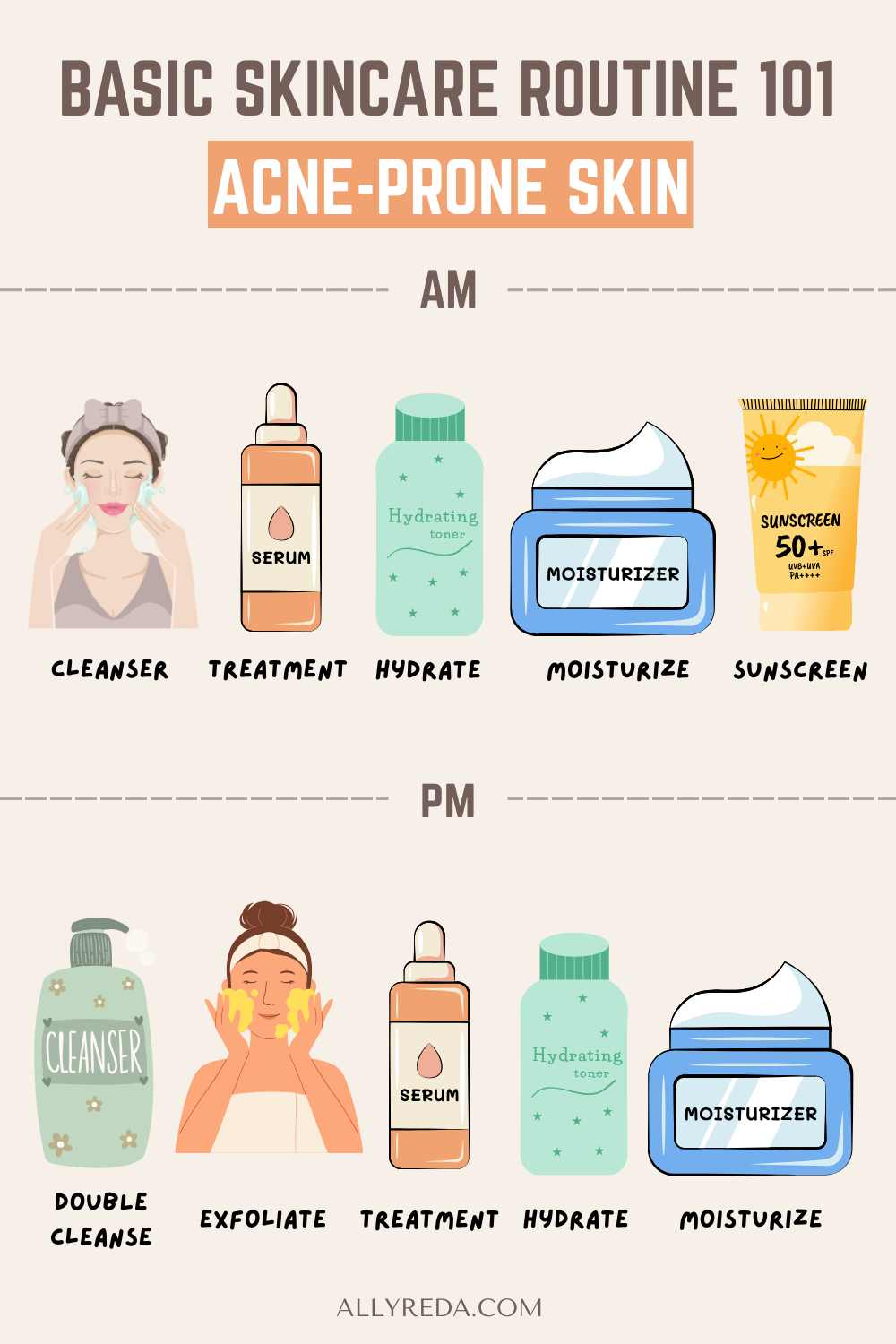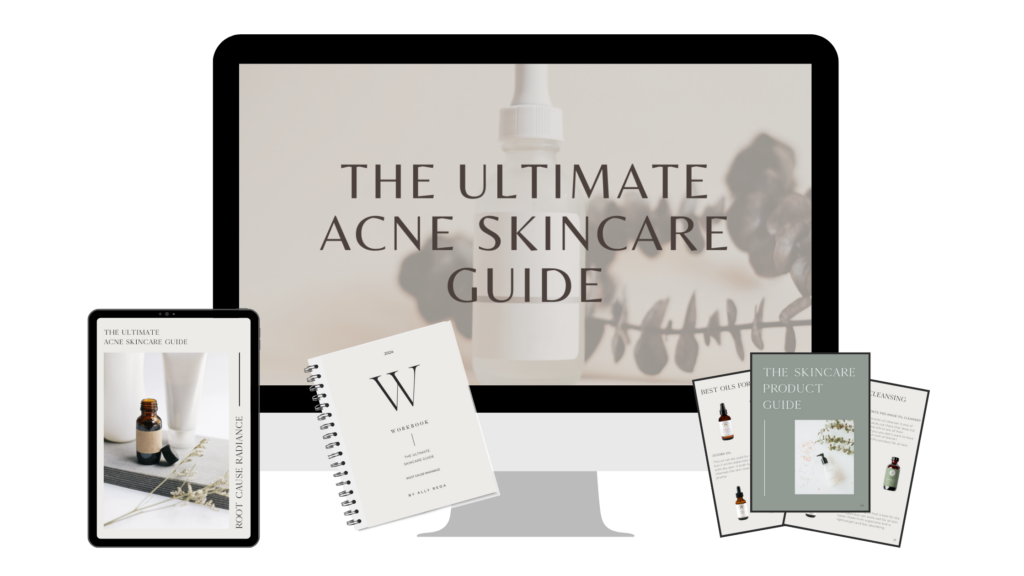The Blog
AM + PM Skincare Routine for Acne-Prone Skin

Your simple, no-stress guide to clear, balanced skin
If your skincare routine feels more confusing than helpful (hello, 12 half-used serums), let’s hit reset. The truth is, a basic skincare routine can be way more effective, especially if you’re dealing with breakouts, sensitivity, or damaged skin.
This guide breaks down a realistic, acne-friendly AM and PM routine that’s gentle, effective, and easy to follow—even if you’re just getting started with skincare 101.
Not sure what your morning and night routine should actually look like for acne-prone skin?
This Guide takes out the guesswork. You’ll learn exactly what to use (and when), how to layer your products, and which steps are totally optional. It’s like a plug-and-play routine for calmer, clearer skin—without the overwhelm.

Morning Routine: Keep It Light, Calm, and Protective
Your morning skincare is all about setting your skin up for the day ahead. Think: cleanse gently, hydrate, protect.
Step 1: Cleanse (Gently!)
Choose what your skin needs that morning:
- Gentle Cleanser – Massage onto damp skin for 30–60 seconds, rinse with lukewarm or cool water.
- Honey Cleanse – Raw or Manuka honey on dry skin for 1–2 minutes, then rinse. Great for sensitive, inflamed skin. Use 2–3x/week max.
No need to cleanse in the morning if your skin feels fine—trust your skin’s signals.
Step 2: Treatment (Optional)
This is where you can bring in a niacinamide serum—a powerhouse ingredient that helps reduce excess oil, minimize the appearance of pores, and support a more even skin tone. It’s especially helpful for oily or congested skin types.
But heads up: Niacinamide can be a little too much for dry or sensitive skin, especially in early healing phases. If your skin barrier is still recovering, it’s totally okay (and smart!) to skip this step for now.
Step 3: Hydrate
Hydration is key to any acne-friendly routine. After cleansing (and applying any treatment), spritz your skin with a thermal water spray, apply a hydrating toner, or use a lightweight hydrating serum.
Why it matters: This step helps prep your skin to better absorb your moisturizer, while also calming inflammation and supporting a strong, resilient skin barrier.
Step 4: Moisturize
While your skin is still damp from hydration, seal it in with a nourishing moisturizer or oil. This helps prevent transepidermal water loss and keeps your barrier happy.
Options to love:
- Squalane Oil: Lightweight, non-comedogenic, and deeply hydrating. Perfect for all skin types, including acne-prone.
- Gentle Moisturizer: Choose one that’s fragrance-free and barrier-repair focused—bonus points if it includes ceramides or panthenol.
Step 5: Sunscreen (Optional but Recommended)
Use a zinc-based sunscreen daily, especially if you’re treating acne or healing dark spots. If your sunscreen is hydrating, you can skip moisturizer.
Evening Routine: Reset + Repair
Your skin heals at night, so your PM routine is all about cleansing well and nourishing deeply, without overdoing it.
Step 1: Double Cleanse (Only If Needed)
Wore makeup or SPF? Do a double cleanse:
- Oil-Based Cleanser or Balm
- Follow with a Gentle Cleanser or Honey Cleanse
No makeup? One cleanse is plenty.
Step 2: Exfoliate (1–2x a Week)
Use a Manuka honey mask—apply to dry skin, leave for 3–10 mins, rinse with warm water.
It exfoliates gently, soothes inflammation, and won’t wreck your barrier.
Step 3: Treatment (Optional)
If your skin tolerates it, you can use:
- Niacinamide Serum – Stick with it only if it’s working for you
Step 4: Hydrate
Just like in the AM—use a mist, toner, or hydrating serum to help your skin soak up moisture.
Step 5: Moisturize
Seal everything in with:
- Squalane Oil – Lightweight + healing
- Gentle Moisturizer – Barrier-supportive, non-comedogenic
Step 6: Spot Treatment (If Needed)
Apply only on active breakouts—and always after your moisturizer to avoid irritation.
Things to Keep in Mind
If you’ve been using benzoyl peroxide, salicylic acid, or retinoids, you can’t just quit cold turkey—your skin will likely push back (hello, surprise breakout). These ingredients are powerful, and your skin gets used to them over time, so the goal is to taper gently.
Here’s how to do it the smart way:
- Apply treatments after your moisturizer to buffer the strength and reduce irritation.
- Start by removing morning applications first, then gradually reduce the number of days per week you use the product.
- If your skin does well with these treatments, you don’t have to cut them out completely. You can continue using:
- Benzoyl Peroxide: 2.5–4%
- Salicylic Acid: 2%
- Especially helpful for very deep, cystic breakouts.
- If you have dry or sensitive skin, start by cutting back slowly. For example, I have sensitive skin and can tolerate a 4% benzoyl peroxide cleanser in the morning only. That’s it.
Give your skin 2–3 weeks after each change to adjust before removing something completely. Don’t rush it.
Reminder: If your routine includes something that seems to be working for you but doesn’t align with these guidelines, check in with me or trust your gut. Skincare isn’t one-size-fits-all. Trial and error is part of the process—this guide just makes that trial easier and way less stressful.
Ice Rolling
Ice constricts blood vessels, which helps reduce swelling and inflammation. It also improves product absorption and leaves your skin looking calmer and less puffy. Here’s how to get the most out of it:
How to Ice Roll:
- Use medium to light pressure and roll in gentle, zig-zag motions across your face.
- Aim for 10–15 minutes, morning or night, after your skincare routine.
Best Time to Use:
Apply your treatment product first, then ice roll right after. This helps your skin absorb the product more effectively. Finish with your usual hydration and moisturizer steps.
Why It Works:
- Calms red, inflamed acne
- De-puffs tired or swollen skin
- Boosts blood flow = better product penetration
It’s simple, soothing, and feels so good, especially on hot, inflamed skin.
Final Thoughts
If you’re overwhelmed with products or stuck in trial-and-error mode, this is your sign to simplify. A basic skincare routine works because it’s gentle, consistent, and barrier-supportive.
When your skin calms down, it can actually focus on healing.
If you’re ready to go deeper, to learn how your hormones, gut health, stress, and detox pathways impact your skin, join me inside Root Cause Radiance. It’s where we connect the dots and create real, lasting change.
Rooting for you always,
Ally
Be the first to comment